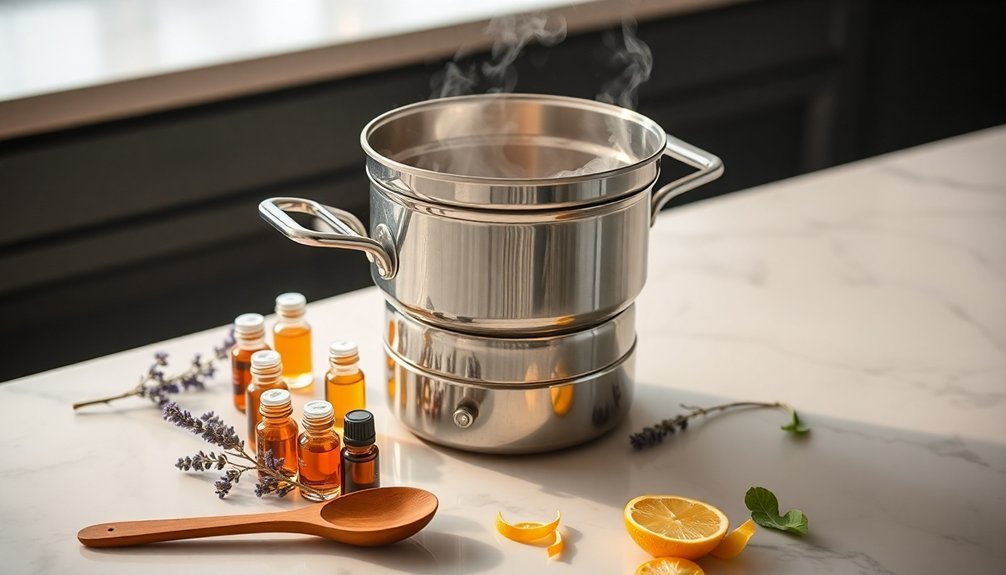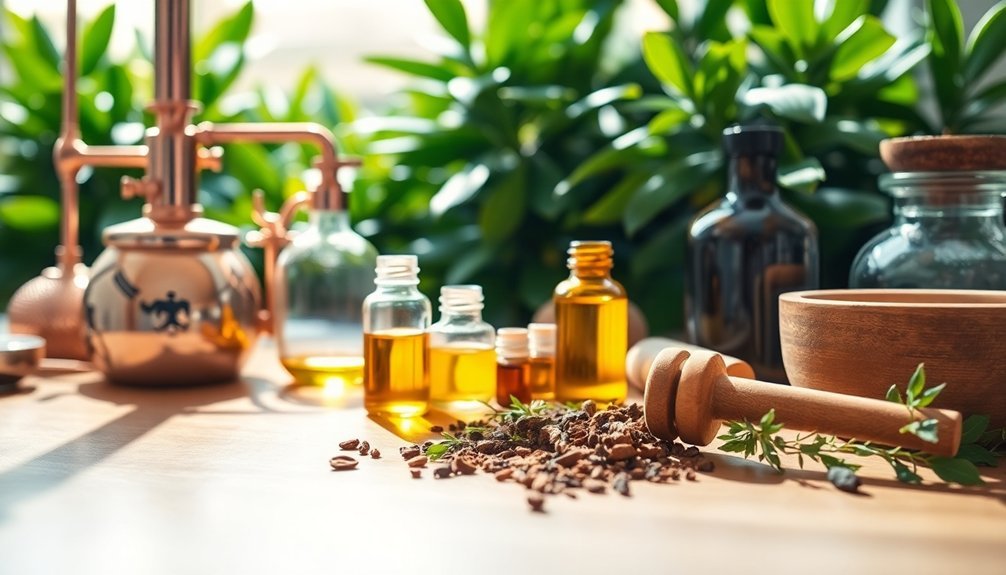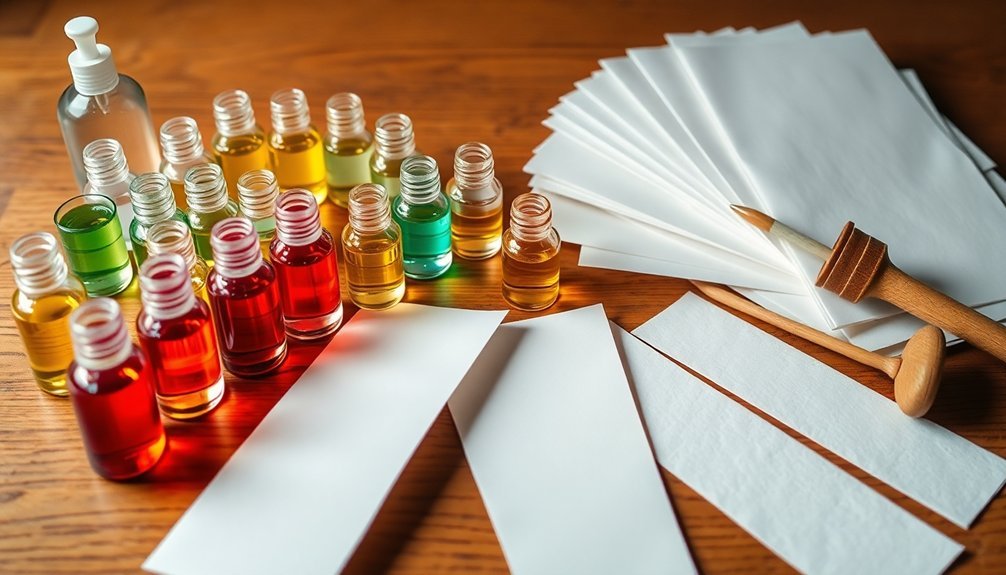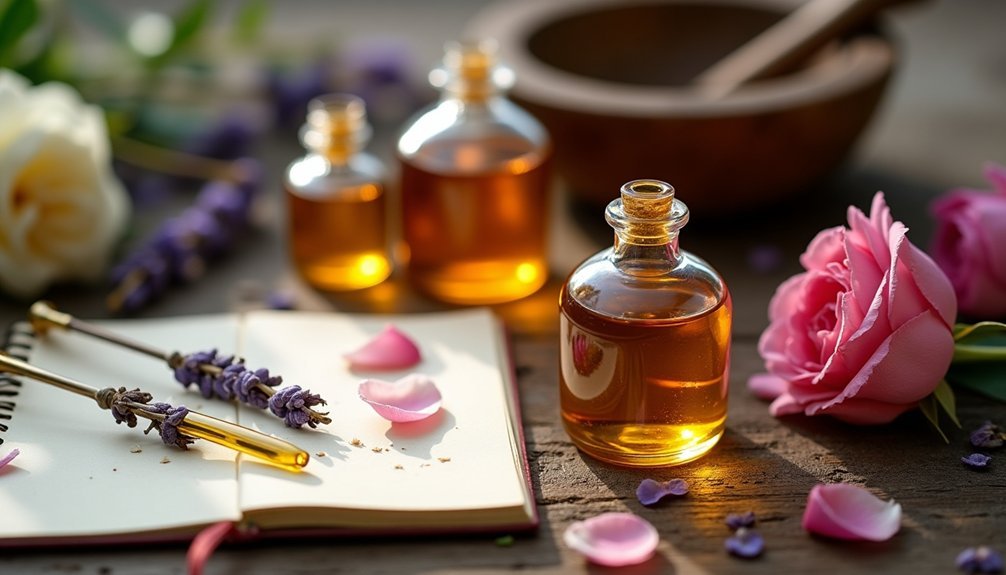You'll need five essential tools to create natural oil perfumes: a double boiler setup for safe heating, borosilicate glass tools for precise measuring and mixing, professional extraction equipment for processing botanicals, dark glass storage bottles to preserve your creations, and scent testing strips for evaluating fragrances. Each tool serves a specific purpose in the perfume-making process, and mastering their use will help you craft unique, high-quality scents that capture nature's essence.
The Essential Double Boiler Setup

When crafting natural oil perfumes, a double boiler setup serves as your essential tool for safely melting and blending ingredients.
You'll need a lower pot filled with water and an upper heat-resistant container that doesn't touch the water's surface.
To create your setup, fill the bottom pot with water below the upper container's base. Place your stainless steel bowl or pot on top, ensuring it fits securely.
As you work with ingredients like beeswax and carrier oils, you'll want to maintain a steady temperature while stirring regularly. Keep a thermometer handy to monitor heat levels and prevent ingredient damage.
Remember to position your double boiler away from flammable materials, especially when working with volatile substances.
This gentle heating method, also known as bain marie, provides the perfect environment for creating aromatic blends without compromising their integrity. This ancient technique was originally developed by early alchemists to carefully control heat during their experiments.
Glass Measuring and Blending Tools
The precision of glass measuring tools forms the backbone of successful natural perfume creation. You'll find that borosilicate glass tools offer exceptional durability and resistance to both heat and chemicals, making them ideal for handling essential oils and other fragrance ingredients. These tools enable accuracy in measurement, which perfumers consider a top priority.
| Tool Type | Primary Use |
|---|---|
| Beakers | Mixing and temporary storage |
| Cylinders | Precise volume measurements |
| Pipettes | Transferring small quantities |
| Droppers | Essential oil dispensing |
Before using your glass tools, always wash them with soapy water and sterilize with ethanol to prevent cross-contamination between different fragrances. This cleaning ritual isn't just about hygiene—it's essential for maintaining the purity of your scents. You'll appreciate the clear visibility these tools provide, allowing you to measure ingredients with confidence while ensuring consistency in your perfume formulations.
Natural Oil Extraction Equipment

Professional oil extraction equipment serves as your gateway to creating authentic natural perfumes from raw botanical materials.
You'll need key components like a boiler to generate steam, a column to hold your botanicals, and a condenser to cool and separate the oils. Most equipment is crafted from food-grade stainless steel or copper to guarantee safety and ideal heat conductivity.
For precise control, you'll want extraction tools with built-in thermometers and control panels to monitor temperature and pressure. An integrated PLC system simplifies the entire operation process.
Choose between methods like steam distillation for most botanicals, or solvent extraction for delicate materials that yield small amounts of oil. If you're concerned about preserving sensitive aroma compounds, consider equipment with vacuum low-temperature extraction capabilities and foam breakers to maintain quality during the process.
Storage and Preservation Containers
After mastering the extraction process, proper storage becomes your next priority for preserving precious natural oils.
You'll need to focus on selecting containers that protect your oils from degradation while maintaining their potency.
Dark-colored glass bottles with airtight screw-top caps are your best choice, as they shield against light damage and prevent oxidation.
- Use amber or cobalt glass bottles for maximum UV protection
- Replace plastic containers, which can react with and contaminate your oils
- Select bottles with secure, screw-top caps or stoppers
- Label each container with the blend name, date, and oil ratios
Store your collection in a cool, dark place between 60-70°F, away from bathrooms and direct sunlight.
Consider using storage cases or organizers to keep your bottles safely arranged and easily accessible.
Scent Testing Materials and Strips

Successful perfume making hinges on proper scent testing materials and techniques. You'll need fragrance testing strips to accurately assess aromas and create consistent blends. These strips prevent cross-contamination and allow you to evaluate multiple scents simultaneously while protecting your skin from concentrated oils.
| Essential Tools | Key Benefits |
|---|---|
| Testing Strips | Reveals full aromatic complexity and prevents skin irritation |
| Droppers/Pipettes | Guarantees precise application of 1-2 drops per strip |
| Labels/Journal | Helps track combinations and replicate successful blends |
To use testing strips effectively, apply a drop of oil to the strip's end, label it clearly, and allow the scent to develop. When blending, you can compare multiple strips side by side, adjusting ratios until you achieve your desired fragrance profile.
Frequently Asked Questions
How Long Does Homemade Natural Perfume Typically Last Before the Scent Fades?
Your homemade natural perfume will typically last 2-4 hours before fading. You'll get longer wear if you've used base notes like sandalwood, applied it to moisturized skin, and stored it properly.
Can I Mix Synthetic and Natural Essential Oils Together?
Yes, you can mix synthetic and natural essential oils together. They'll often complement each other, with synthetics helping to stabilize and extend the life of natural oils while maintaining a balanced fragrance profile.
What Ratios Work Best When Blending Different Essential Oils?
You'll want to follow the 30-50-20 rule: 30% top notes (like lemon), 50% middle notes (like lavender), and 20% base notes (like cedarwood). Adjust these ratios based on individual oil strengths.
Are Certain Combinations of Essential Oils Known to Cause Allergic Reactions?
You'll need to be cautious when mixing citrus oils together, as they can increase skin sensitivity. Also, combining multiple potent oils like clove and tea tree can heighten your risk of allergic reactions.
How Can I Make My Natural Perfume Project Stronger on Skin?
You'll get a stronger scent by increasing essential oil concentration to 20-40%, applying to moisturized skin and pulse points, and using more fixatives like myrrh or benzoin in your natural perfume blend.
In Summary
You're now equipped with the fundamental tools needed to start creating your own natural oil perfumes. Keep your workspace organized with these five essential items, and you'll be ready to blend unique fragrances safely and effectively. Don't forget to maintain your equipment properly and store it separately from your perfume ingredients. As you practice, you'll discover which tools work best for your specific perfume-making style.





Leave a Reply